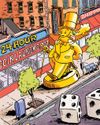
Ed is Ed Blaine, and he works as the logistics manager for a large, local moving company. On the company's organization chart, Blaine is two rungs below the president and founder of the company. He works with five colleagues who are peers and with whom he is not close. Until the last few months, Blaine got to work early and left late. He worked hard to be noticed. He worked hard to contribute to the organization. Lately, he has begun to feel he is being overlooked for a promotion or pay reward. Soon he started leaving early as well.
His annoyance spilled into his marriage. His wife became frustrated and angry over his behavior with the kids, which was dismissive.
Blaine recently skimmed a book on employee coaching. He wasn't quite sure what led him to pick it up; he just did. The book made the following points, namely that:
• Employee coaching is essential
• It needs to be ongoing Coaching should be participatory
• It should be led by outsiders with little knowledge of the organization
• There is a difference between being coached and being self aware
All of these rang true to Blaine, especially the part about being self-aware. So he took the concept to management. Nothing. Weeks passed, then months.
This story is from the {{IssueName}} edition of {{MagazineName}}.
Start your 7-day Magzter GOLD free trial to access thousands of curated premium stories, and 9,000+ magazines and newspapers.
Already a subscriber ? Sign In
This story is from the {{IssueName}} edition of {{MagazineName}}.
Start your 7-day Magzter GOLD free trial to access thousands of curated premium stories, and 9,000+ magazines and newspapers.
Already a subscriber? Sign In

How To Ask Family For Money
Your friends-and-family fundraising round doesn't have to be scary and awkward. Here's advice from one of the world's leading investors.

Data Breach Drama: When Trust Turns Costly In A Digital Age
Amid data breaches surges, Indian businesses are prone to financial and reputational fallout. Can cyber insurance emerge as a safeguard?

THE TERRAIN TAMER
Spearheading a California-based, Series D SaaS company is no easy feat. It requires a blend of ownership, innovation, and the ability to handle stress. But Anand Jain, co-founder and chief product officer of Clever Tap, finds his calm by escaping to rough terrain whenever he gets the chance-be it India or Colombia.

THE INTELLIGENT READS
Hardika Shah founded Kinara Capital in 2011 with the mission to address the acute credit gap in the micro-small-medium-enterprises (MSME) sector in India, by providing fast and flexible business capital to small business entrepreneurs. Despite operating in highly competitive and tough market of collateral free loans, Kinara Capital has been steadily growing in Hardika's leadership. In conversation with Entrepreneur, Hardika shares insights on her favourite books.

THE CURSE OF GROWING TOO FAST
FAIRE is a platform for small businesses, but it grew big the wrong way-almost becoming a $12 billion wreck. Here's how it fixed the problem, and why you should think twice before skyrocketing.

There's No Perfect Answer
I worked the same job for 19 years. I hated it, but it paid the bills. Then, in 2017, I entertained an exciting but terrifying question: Could I be an entrepreneur? I wasn't sure, so I needed something that felt like a guarantee. I searched for signs that would feel like a big, clear \"yes!\"

Give Yourself the Gift of Time
Happy holidays! Emmy Award-winning tech expert Mario Armstrong has five recs to get more hours in the day.

How to Become a Main Street Millionaire
It started when I bought one little laundromat. Now I have a whole portfolio of small local businesses that bring in tens of millions in revenue a year. Here's why following my playbook could be your ticket to financial freedom-and saving America's local small businesses.

Want to Better Serve Your Clients? Become Them.
As a designer for brands, starting my own product company gave me a dose of humility-and it changed the way I relate to clients.

How to Succeed With Gen Z Workers
People often say that younger employees are different. But are they? We asked six business leaders what they've learned, and how their teams thrive.